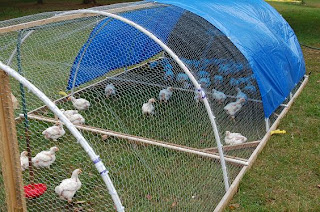Broilers
We raise small batches of Cornish Cross Broilers in the Spring and Fall, mainly for family and friends. When the chickens are ready we have friends over to help with the processing and they stock up on chicken at the cost of production in return. We take the remainder and have exceptional meat available for the family. Processing a couple batches a year is practical and keeps it fun, but if we had to factor in the labor cost of raising and butchering, it wouldn't make a lot of sense. For us, involving friends and family in the learning experience and knowing where our food is coming from is what is important.
The Cornish Cross is the same birds used in commercial systems, but when raised outside on fresh pasture and sunlight, we've found the quality of the meat to be distinctly better. The meat is thicker and firmer, has a deeper taste profile and is nutritionally better. We've also raised heritage and mixed purpose birds, but in this case practicality wins out and we've found the Cornish crosses are much easier to get the kids to eat as well as being economical.
Our system for raising them is pretty simple - Keep the birds moving on pasture. We order day old chicks and set them in the brooder for two weeks. They have free access to un-medicated chick starter during this period. Raising the birds outside on pasture helps us avoid the health issues that can be a real problem in confinement systems, so we can avoid antibiotics and other medications.
 |
| 100 chicks arrive and huddle up in the brooder |
At two weeks, the chicks are placed in a portable chicken coop where they can scratch around for bugs and eat fresh grass. They also get a grower ration, which I can load into a feed hopper from the outside of the coop. There is a gravity triggered automatic watered that I simply connect to a hose, which provides the birds with fresh, clean water around the clock.
 |
| Chicks at 2 weeks |
The coop gets dragged around the property to give them access to fresh pasture. They also leave behind a nice pile of fertilizer, which helps to provide nutrients and organic content to build healthy soil. The laying chickens, Geese and Guineas clean up any spilled feed. This system also protects the birds from predators and themselves. The Cornish Crosses grow so quickly they don't get a chance to develop the self preservation and foraging instincts that we see in the laying flock. We've found that they are basically eating machines and don't stray very far from the feed hopper. (Did you know that most USDA certified Free Range Chickens never see pasture?)
 |
| Layers Foraging for leftovers |
These birds grow fast! Before long they're no longer the cute fuzzballs that come in the mail.
 |
| Chickens at about 6 weeks |